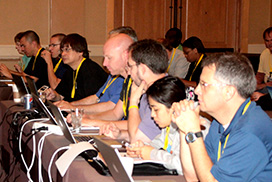Day 1: Establishing an AIInfused Enterprise Architecture Foundation
Introduction to Enterprise Architecture in an AIDriven World
- Understanding the evolving role of enterprise architecture as a strategic enabler of AI adoption
- Aligning architecture domains and layers with intelligent automation, generative AI, and autonomous agents
- Leveraging EA maturity models to guide the integration of generative AI, GPT models, and assistive coding tools
- Embedding AI considerations into digital transformation initiatives and IT governance frameworks
- Establishing best practices for EA documentation, leveraging AIdriven blueprints, reference models, and accelerators
Digital Transformation with AIEnhanced Enterprise Architecture
- Defining digital transformation Vision in the context of autonomous agents, predictive analytics, and realtime inference
- Integrating AIdriven insights into digital initiatives to enhance agility and competitive advantage
- Exploring established frameworks (e.g., TOGAF, Zachman) and adapting them to the AI age
- Identifying the benefits, challenges, and future trajectories of AIenhanced digital transformations
Digital Business Architecture for Intelligent DecisionMaking
- Linking business strategy and outcomes to AI/MLdriven capabilities
- Mapping capabilities to incorporate autonomous agents, recommendation engines, and predictive maintenance
- Leveraging industry-specific models (finance, manufacturing, SaaS) to illustrate real-world AIdriven innovation
- Crafting customer journey maps and value streams enriched by generative AI and knowledgegraph insights
Application Architecture & Modernization for AI
- Transitioning from baseline to target architectures that embrace RAG (Retrieval Augmented Generation) and GraphRAG methodologies
- Identifying capability gaps and opportunities to introduce generative models and predictive analytics
- Decomposing capabilities
- Managing application portfolios to incorporate vector databases, graph databases, and microservices that support AIdriven features
Data Architecture & Industry Standards
- Designing a common data model ready for large-scale training and inference with generative AI and autonomous agents
- Implementing master data management for high-quality input into AI pipelines
- Ensuring compliance with GDPR, mitigating bias, and embracing responsible AI principles
- Introducing vector databases and knowledge graphs to power retrieval and relational reasoning in AIdriven use cases
Information Systems Architecture & Integration
- Structuring information flows for real-time inference, leveraging event-driven and streaming architectures and design patterns
- Integrating vector stores, graph databases, and analytical platforms to support RAG and GraphRAG
- Establishing patterns for model lifecycle management, encompassing deployment, scaling, and continuous optimization
Day 2: Deep Dive into RAG, GraphRAG, and Operationalizing Autonomous Agents
Technology Architecture for AIEnabled Environments
- Planning infrastructure, cloud architectures, and AI DevOps practices to support large-scale training, inference, and vector/graph data retrieval
- Enabling Guardrails and user testing
- Implementing InfrastructureasCode and continuous delivery approaches for rapid AI model updates
- Adopting technology standards and governance policies that encourage experimentation and innovation
AWS Cloud Adoption Framework for Artificial Intelligence, Machine Learning, and Generative AI
- Evaluating AWS, Azure, and GCP frameworks through an AIcentric lens
- Evaluate foundational AI capabilities to improve cloud readiness, focusing on Business, People, Governance, Platform, Security, and Operations.
Governance & Implementation of AIDriven EA
- Establishing governance structures, Architecture Review Boards, and AI ethics committees
- Defining technical reference models that incorporate autonomous agents, RAG pipelines, and GraphRAG knowledge graphs
- Managing stakeholders, performance metrics, and conducting gap analyses to improve AI capabilities and outcomes continuously
Change Management for AIEnabled Transformation
- Assessing organizational readiness, upskilling teams, and communicating the strategic value of AI
- Navigating the cultural shift towards trust in autonomous agents and AIdriven decision-making
- Using simulations and roleplaying exercises to model real-world scenarios and mitigate adoption risks
SAFe Agile Enterprise Architecture & Modern AI Methodologies
- Integrating SAFe Agile principles to iterate on RAGbased autonomous agent solutions rapidly
- Applying IDEO design methodologies for user-centric AI solutions, cocreating with AIbased ideation tools
- Ensuring compliance and governance at scale with intelligent journey mapping and value stream analysis
Implementing RAG and GraphRAG Pipelines in Practice
- Constructing end-to-end RAG pipelines using vector databases and generative AI models (e.g., GPT variants)
- Incorporating graph databases (e.g., Neo4j) to build GraphRAG architectures that leverage relational knowledge
- Optimizing autonomous agents for real-time retrieval, inference, and context-aware responses
- Hands-on examples demonstrating how to integrate code, embeddings, vector searches, and graph queries
Enterprise Architecture & AI Case Studies
- Examining how a global insurance firm leverages GPTbased claims processing, GraphRAGdriven risk assessment, and predictive fraud detection
- Exploring how a manufacturing leader uses RAGbased predictive maintenance agents, AR/VR for training and generative design tools
- Identifying lessons learned, pitfalls, and success factors from real-world AI and EA transformation stories
Roadmapping & Future Trends
- Summarizing key insights, patterns, and best practices from both days
- Developing a 3-year technology roadmap that integrates generative AI, RAG/GraphRAG agents, vector/graph databases, AR/VR, edge computing, and blockchain
- Engaging in an interactive Q&A and discussing the next steps to architect an AI-augmented enterprise poised for continuous innovation





